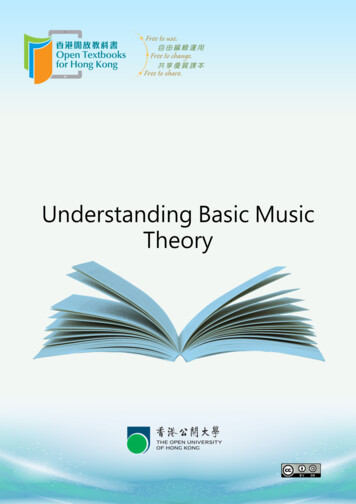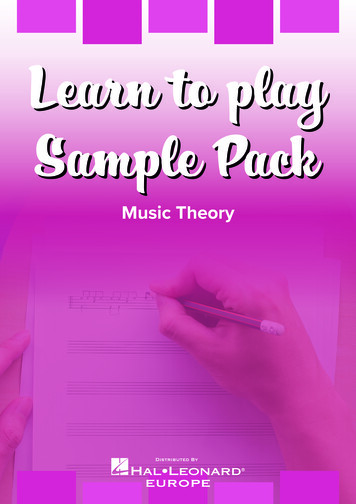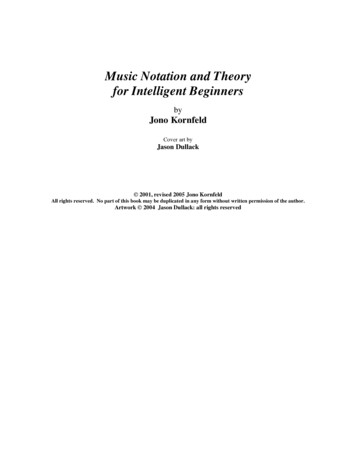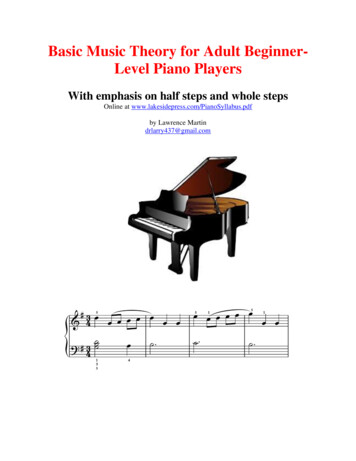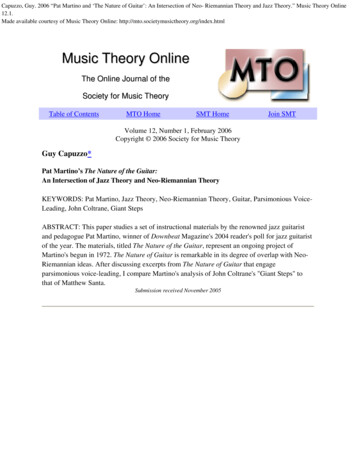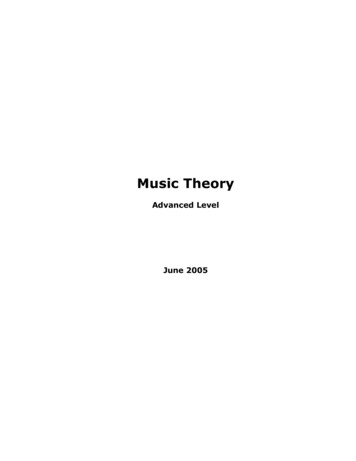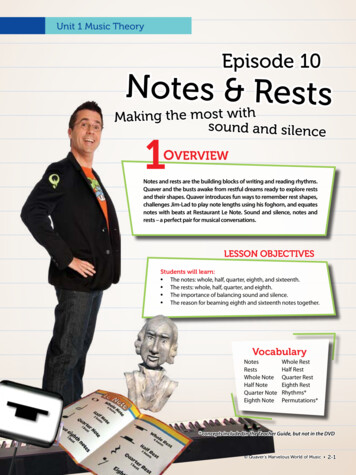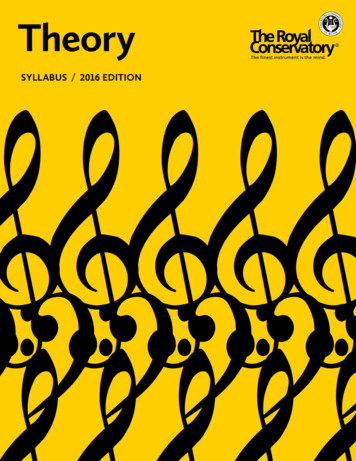
Transcription
Fundamentals ofChurchMusicTheoryAn elementary studyof music theory as itapplies to the churchbyJames TackettPublished byAustin Christian Acappella Musicfor theTEXAS NORMAL SINGING SCHOOLi
FundamentalsofChurchMusic TheorybyJames TackettRevised 2009Copyright 1993, 2005, 2009byJames TackettAll rights reserved. No part of this book may bereproduced or utilized in any form or by any means, electronic or mechanical, including photocopying or recording, orby any informational storage and retrieval system, withoutpermission from either the author or publisher.Printed in U. S. A.ii
DEDICATIONThis book is dedicated to my wife, the most wonderful person in the world. Since 1972, Wally gives me time to teachsummer singing schools. Since 1979, she gives me eveningsfor singing practice and THE SWEET EXPRESSIONS concerts. We seldom get to sit together at church because Iusually lead singing. She also gives me many an evening toarrange songs, work in the recording studio, or write books.Since 2000, she allows me to spend most of my waking hoursat the computer working on the many aspects of The Paperless Hymnal .Throughout these activities, Wally remains my inspiration,always encouraging me to see things through. Her hardwork in whatever she does continues to rub off.Thanks Honey!!!Most importantly, I want to dedicate this book to the Lord.He is my reason for singing and wanting others to helpothers better enjoy praising Him better through song.Thank you Lord!!!iii
PREFACEFUNDAMENTALS OF CHURCH MUSIC THEORY is specifically designed foruse at The TEXAS NORMAL SINGING SCHOOL and other church music singing schools. Careful attention is given to the content, assuring a solid background for individuals beginning their in church music education.This text results from time proven methods. Instructors of this school successfully employed these techniques in their work at the TEXAS NORMAL SINGING SCHOOL in Sabinal, Texas, the TEXAS SINGING SCHOOL at TRINITYUNIVERSITY in San Antonio, Texas, the ACAPPELLA CHRISTIAN MUSICSEMINAR in Paris, Tennessee, and Murray State University in Murray, Kentucky, and the SINGING SCHOOL at ABILENE CHRISTIAN UNIVERSITY.Since 1988, this has been our primary text for beginning students.If planning to teach church music, you will find this material organized in aneasy-to-present order. Exercises for each chapter help build skills in each content area. Twelve to eighteen hours are needed for lecture time, with an additional twelve to twenty-four hours for application.Students will like the building block approach of the material. All terms aredefined as they are presented in the text.For information about the one week summer session or other material published by The TEXAS NORMAL SINGING SCHOOL, please write to the following address:The TEXAS NORMAL SINGING SCHOOL8705 Bridgeport Dr., Austin, TX 78758(512) 785-9303www.singingschool.orgThis book may be download at:www.paperlesshymnal.comAustin Christian Acappella Music8705 Bridgeport DriveAustin, Texas .comiv
TABLE OF r1 - Sound12 - Pitch Notation5Properties of a tone. Properties of a song.The staff. The G clef. The F clef. The C clef. Names of the degrees.3 - Scales134 - Relative Pitches195 - Pitch Modification & Keys236 - The Chromatic Scale377 - Length Notation438 - Rhythm519 - Bars, Repetitions & Endings5710 - Power & Tempo63Appendix 1 - Quick Music Reference67Appendix 2 - Key Signatures68Index and Glossary69Octaves. Steps and half steps. The minor scale. The major scale.The diatonic scale. Shaped notes.Sharps and flats. Key signatures. Accidentals. Naturals.Double sharps and double flats.Time signatures. Length of tones and rests. Ties and slurs.Triplets. Counting notes.v
INTRODUCTIONAs you look through this book the first time, you will notice the use of "shaped notes". Thosewho are familiar with shaped notes may think of “Sacred Harp”, which is not taught here.This is the seven shape variety. I offer the following by way of explanation for their use."The peculiar system of notation used in this book is of modern date, being the invention of J. B. Aiken, in the year 1847. Its special advantage over round notes consistsin representing each note of the scale by a distinct character. Hence, the reading ofnotes is greatly simplified, and the learner finds no difficulty in singing by note in anyof the keys; and this shape (that of Do) is the keynote, wherever found upon the staff. ."This system is not an old one, as some suppose, but is the reformed notation of a progressive age, and has been steadily gaining in public favor. Itsgrowth, like that of the Alpine avalanche, has been slow; but, like an avalanche, it seems now ready to sweep before it all opposing obstacles. Especially of late years has it gained strength and volume, until many of the publishing houses of influential Christian denominations have endorsed it. ."Aside from these endorsements, however, there are many others of equalimportance. Shrewd business men are beginning to discover the vast strengthwhich this system of notation is developing, and are showing a willingness toaid and abet that system which certain musicians, years ago, pronounced adangerous delusion. . That character notes must eventually become the standard notation of the country is evident, and only becomes a question of time."The quote is from a hymnal published in 1879 by Ruebush, Kieffer and Co.; called SHINING LIGHT. Shaped notes never did become the standard because instrumentalists opposed them. Since our institutes of higher learning usually base their instruction methodson instruments, they see no need for "helps", or as they call them “crutches”, in vocal instruction, considering them to be extra baggage. After all, they will have the voice student for several years, not the few days available to us in summer singing schools. Mostchurches are willing to allow whatever music training their members receive to comefrom public education or the music departments of our colleges. The lack of music education on the part of our song directors and members in general most hurts our singing.Few worshippers have studied music to any great degree and thus need as many "helps"as possible. It is assumed that this is the first music training for students using thisbook. For that reason shaped notes are used so that they "can learn to read music in thisnotation so much sooner than if printed in the antiquated system" (SHINING LIGHT).vi
1SOUNDScope: The basic elements of a tone and musicThe world around us is filled with sound. Sound is produced when objects vibrate. Vibrationscan occur at irregular or regular time intervals. Sounds produced by irregular vibrationsare considered noise, while sounds produced by regular and repeated vibrations are morepleasing. Therefore, a good definition of music for this study is “sounds organized within aframework of time”.ToneA tone is a single musical sound, and thus is the smallest unit of music. Tones have fourproperties: pitch, length, power and quality.PitchPitch is the highness or lowness of a tone. Higher tones are produced by a larger number ofvibrations per second than lower tones. In the illustration below, tone A has a higher pitchthan tone B.LengthLength is the duration of a tone. The longer a tone lasts, the greater its length. The illustration shows tone B having greater length than tone A.PowerPower is the intensity of a tone. The stronger a tone’s vibrations, the greater its power.Power is equivalent to volume. The greater the power, the louder the tone. The illustrationshows that tone B has greater power than tone A.QualityQuality is the property of a tone that enables a listener to distinguish the voice of one personfrom that of another, a trumpet from a trombone, etc.1
Chapter OneSongA song is a complete work of music that uses many tones. A song has four properties: melody, rhythm, harmony and lyrics.MelodyA melody is a series of tones. Melody is the property that allows a listener to distinguish onesong from another. It is often called the tune.HarmonyHarmony is the simultaneous sounding of multiple tones having different pitches. Thesounds produced by harmonies are usually pleasing to the ear.RhythmRhythm is the regular pattern of groups of tones determined by tone length. A pattern isformed by tone length within each group coupled with sounding of certain (accented) toneswith more power.LyricsLyrics are the words used when singing a song.Information included with a songIn addition to the song music and lyrics, additional information is included.Authors and song titleNames associated with the song lyrics are shown beneath the title, at the upper left. This includes the author of the words and may include the translator and/or lyric editor.Names associated with the music are shown beneath the title, at the upper right. This includes the authorof the melody and could include the name of the arranger.The single dates identify when the words and music were written. If the year of authorship is unknown,the date that the words or music first appeared in a publication, or the copyright date, are sometimesshown. If a date is shown as a range of years as in (1908-1995), it identifies the date of birth and death ofthe author.The title of the song is usually the name given to the lyric poem by its author. Some song books use thefirst words of the first stanza as the song title.2
Chapter OneCopyright informationThe copyright information is found at the bottom of the first page of the song. The word“copyright” is not always used, but the symbol “ ” must always appear. The date after thecopyright symbol is the year that the song owner filed the copyright application. The copyright statement does not have to be present for the material to be considered under copyright protection. It could have been left off when an unauthorized copy was made. To be safe,assume a song to be under copyright unless there is compelling information that shows it isnot.Songs originally written on or after 1978 maintain their protection under the US copyrightlaws for the life of the author plus 70 years. All hymnals in print today have an index whichlists author birth and death dates. You can no longer look at new songs and know whencopyright protection for the song will end.Songs written before 1923 had protection for 28 years and could be renewed for an additional 28 years, giving them a total of 56 years of protection. In 1976, the renewal was changedto 47 years, giving songs then under copyright 75 years of protection.Generally, songs written between 1923 and 1978 have 95 years of protection. This is thecase of the illustration above. The copyright protection for this song will expire in 2019.The name of the copyright owner follows the copyright date, in this case Hope PublishingCompany. The phrase “All rights reserved” indicates that Hope retains all rights to thesong. The phrase “Used by permission” indicates that the editor of the publication in whichthe song is printed has obtained permission to use the song.Music: art & scienceMusic is both an art and a science.The properties of a tone can be defined in scientific terms. The pitch of a tone can be measured in Hertz (vibrations per second). Length can be measured in seconds or fractions ofa second. Power can be measured in decibels (db), a unit defining the strength of a sound.Rarely is a sound, produced by a person or an instrument, made up of a single tone. Severaltones usually sound simultaneously, each at a different pitch and power. The unique combination of tones and the power of each determines the quality or uniqueness of the sound.Each of the tones within the sound, called overtones, can be measured.Though music can be precisely defined in scientific units of measurement, it is not usuallypresented in that manner. Freedom in producing the actual pitch, length, power, and quality for each tone allows expression on the part of the one who produces the music. Therefore,music is also an art form.Summary: This chapter lays the groundwork for the remainder of the book. Chapters 2- 6 explain pitch, chapter 7 discusses length, chapters 8 - 9 discuss rhythm, and chapter10 deals with power.3
Chapter OneExercisesName the four properties of a tone:1.2.3.4.Name the four properties of a song:5.6.7.8.Name the measurement units for the following:9.Pitch10.Length11.Volume4
2PITCH NOTATIONScope: The musical staff, the G Clef, the F Clef, the C Clef, voice partsMusic, a written languageLanguages must have a written form in order to preserve expressed thoughts. Music’s written form is notation.Pitches are graphically represented on a staff consisting of five lines and their associatedspaces.Each line and each space is called a degree. The staff makes eleven degrees available.Ledger lines can be used to extend the staff and make additional degrees available.A brace designates a set of five lines as a staff.5
Chapter TwoA clef at the beginning of each staff designates the pitch range to be sung. Since the femalevoice is higher in pitch than the male voice, a G Clef (Treble Clef) & is added at the beginningof staves designating the female pitch.An F Clef (Bass Clef) ? is placed at the beginning of a staff to designate the male pitchrange. The F Clef on the right was used in the past.Sometimes, high male pitches or low female pitches are represented on a staff designatedwith a C Clef, B, V, or D. The C Clef on the left is used mostly for instruments. The clef inthe middle is now used more than the clef on the right.Each degree on a staff qualified by pitch range (defined by adding a clef sign), has a name.The names of pitches represented on a staff are A, B, C, D, E, F, and G. B has a higher pitchthan A, C has a higher pitch than B, etc.The G Clef is placed around the second line from the bottom of the staff. This line becomesG.Sta
FUNDAMENTALS OF CHURCH MUSIC THEORY is specifically designed for use at The TEXAS NORMAL SINGING SCHOOL and other church music sing - ing schools. Careful attention is given to the content, assuring a solid back-ground for individuals beginning their in church music education. This text results from time proven methods. Instructors of this school success-File Size: 1011KBPage Count: 80


